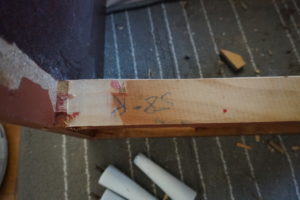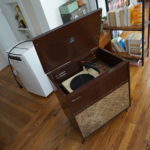Originally, I started this post writing a preamble about nostalgia and my escape from the land of my youth, but maybe this isn’t the place for that story. I will save it for my therapist.
Instead, let me tell you the story about this radio console of mysterious provenance.
The gods of free stuff were once again smiling down upon me when I found the listing for this beautifully conceived little piece of mid-century history. My first contact to obtain the radio was met with polite rebuff: I am far from the only person scouring Craigslist for choice finds. However, like many times before, my perseverance paid off when the original takers failed to abscond with the offering.
Though the radio bears the Emerson logo, in several places, my attempts at researching some additional history of this particular model came up almost entirely fruitless. The only thing I could find was an auction listing from an estate sale website for a similar radio, with no additional information.
Based on the design and the electronic components, I estimate that this unit is from the late 50s/early 60s. Despite a few cosmetic scratches, dings and scrapes, the only other major issue was a loose leg. Not bad at all for something roughly 60 years old.
My first step was to start breaking it down and assessing what work I had ahead of me. I had already decided that I wanted to somehow convert it to a modern Bluetooth stereo console, similar to what I had accomplished with the Oil Furnace Stereo Console, so I knew that I needed to gut the original electronics. I also removed the speaker grille panel and the lid, for ease of access and refinishing.
After dumping all the electronics into a box and putting them out on the corner as an offering to the gods of free stuff, I eagerly rolled up my sleeves and dove into stripping the lid and the shell.
Or, so I had hoped. You see, the gods of free stuff are not above throwing the occasional and proverbial monkey wrench into my plans and this was an occasion on which they assuredly reveled in the disruption caused by their machinations. After slathering a healthy layer of stripper on the lid, I began to scrape away the molted remains only to discover, much to my shock and dismay, laminate where I had expected to find wood.
A quick test of the shell revealed the same fate was in store for me there. It was then time for me to make the difficult decision to either cover the whole thing in wood veneer or do the unthinkable and paint it.
Sometimes in life it is necessary to take a deep breath, realign our expectations and embrace the unthinkable. Paint it was to be.
Seeing how neatly the console was gutted, I finalized my plans for the ultimate purpose of this piece: Install a false floor, under which the stereo components would be installed, and convert the top into storage. In order to accomplish that, I would first need to finish gutting all the wood framework from the inside of the shell.
There was a little bit of play in the shell, so I took the time to reinforce the construction with a little yellow glue.
While the glue was drying, I turned my attention to the legs. Given my experience with the Lane Acclaim tables (you can review the treachery of that deception in Memory Lane, Part 3) and the construction of the rest of this console, I would have willingly bet money that the so-called “metal caps” on these legs were plastic at best. Especially considering that one of them was split, which is not necessarily a property I often attribute to metal (though, now that I think about it, the Liberty Bell split…). I was pleasantly surprised to find my pessimism was ill-placed.
Having discovered that the caps were real metal, I mixed up a slurry of Bar Keepers Friend and let them have a relaxing soak. After a bit of a scrub, they shined almost like new.
Once dried, I taped off the caps and primed the legs, and then moved on to repairing the loose leg by gluing the mounting hardware in place and screwing the leg down tight to hold it while the glue dried.
I also discovered this random bit of marginalia. I love finding stuff like this in old pieces of furniture and knowing that some craftsman or craftswoman of a bygone age once took the time to jot down something that was important to him or her. The significance of this writing is lost to the ravages of time, but it makes me happy to find these personal marks in otherwise impersonal pieces of furniture.
 In the next installment of Lamination Lamentation, I tackle painting and building the false bottom. It’s riveting, to be certain.
In the next installment of Lamination Lamentation, I tackle painting and building the false bottom. It’s riveting, to be certain.
























